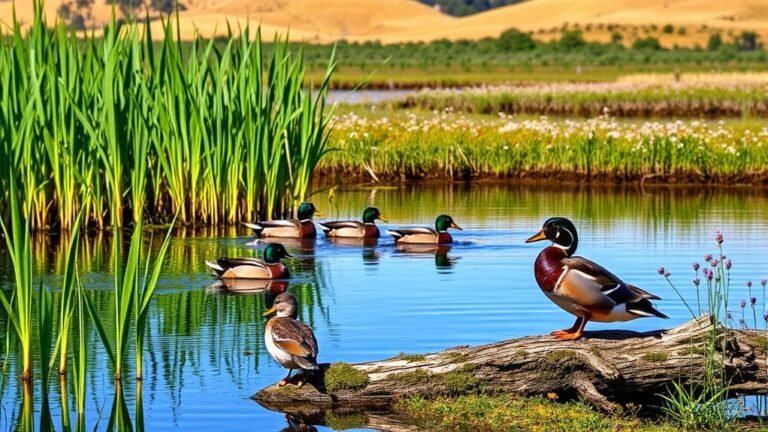Why Do Owls Hoot? Understanding Their Calls
Owls hoot to talk to each other. They use their sounds to share important messages. Hoots help them mark their territory and find mates. Each hoot has a special meaning that shows how healthy the owl is and what it wants to communicate.
Learning about these sounds can help us understand how owls live and interact. Their calls may change due to different environments. This leads us to consider what these changes could mean for their future.
A Quick Overview
Owls hoot to talk to their family. They use hoots to stay in touch with their mates and their young ones. This helps them keep their family close.
Hooting is also a way for owls to say, "This is my space!" They make these sounds to show other owls which areas they claim as their own.
During mating season, male owls have special hoots to catch the attention of female owls. These sounds show they are strong and healthy. It's like saying, "Hey, look at me!"
Each owl has its own way of hooting to share different messages. They can tell other owls about their territory, where food is, or warn them of danger.
Sometimes, noise from cars and other humans can make it hard for owls to communicate. This can make their hooting less effective.
The Role of Vocalizations in Owl Communication

Owls might seem like they prefer to be alone, but they actually use sounds to talk to each other. These sounds are super important for them. Each call has a special meaning. For example, owls call to mark their territory, find a mate, or warn others about danger.
Young owls learn to copy the calls of older owls. This helps them connect with others and stay safe. When owls mimic each other's sounds, it creates stronger friendships and helps them feel like they belong.
Through their unique calls, owls share important messages and build their social groups. Vocal sounds help them understand each other and stay connected.
Types of Owl Calls and Their Meanings

When you listen to an owl, you can hear different calls. Each call has a specific purpose. Common calls include hoots, screams, and whistles. Owls use these calls to communicate, and different species may sound a bit different—this is called owl dialects.
Hooting is often how owls talk to their mates or young ones. On the other hand, sharp screams can mean the owl is scared or in trouble. Some owls can mimic the sounds of other birds or things in their environment. They do this to trick predators or other birds around them.
This ability to make different sounds helps owls survive. It also shows that they're smart. By learning about these calls, you can connect better with nature.
You'll notice how owls interact with each other and their surroundings. Each call gives you a glimpse into their behavior and how they fit into their ecosystem.
Territorial Calls: Establishing Boundaries

Territorial calls are important for owls. These sounds help owls say, "This is my home!" They use calls to show where their territory is, so other owls know not to come too close. The way an owl hoots can change a lot. A loud hoot might mean they're big and strong.
By making special sounds, owls tell others to stay away, keeping their food and space safe. Sometimes, owls' calls overlap. This can make their territory sound bigger. It's like they're creating a map of their area with their voices.
When they hoot in a pattern, it sends a clear message: "I live here!" This helps them protect their space. Learning about how owls use their calls helps us see how important communication is in nature.
Mating Calls: Attracting a Partner
Owls use mating calls to find partners during the breeding season. These calls are important for attracting mates and showing off their strengths.
Male owls often make distinct hoots or whistles. This special sound helps grab the attention of female owls.
The calls can tell females about the male's health and strength. It also shows that the male has his own territory. This helps females choose the best partner.
Sometimes, both male and female owls will call back and forth. This creates a special connection between them.
Learning about these mating calls shows how unique owl relationships are. It's fun to think about how they communicate during breeding time!
Hunting Sounds: Coordinating With Family
Owls make many sounds, and people often think they do this just for mating. But these sounds are super important for hunting and keeping their families together.
Owls use different calls to talk to their family members. This helps everyone work together.
When one owl sees food, it will make special calls. This way, other owls know there's food around without scaring it away. These calls also help strengthen the bonds between family members. Working together means they can hunt better.
By using their voices smartly while hunting, owls show how much they depend on each other. This teamwork helps them find food and stay safe.
Alarm Calls: Warning Fellow Owls
When owls sense danger nearby, they make alarm calls to warn their friends. These calls help all the owls stay aware of what's happening around them and can keep them safe.
Different owl species have different sounds. For example, a quick, sharp hoot means there's a predator close by, while a softer call might mean it's not as serious.
By talking to each other, owls build strong friendships and protect their group. Learning about these calls helps us understand owls better and see how they interact.
Plus, by listening for their sounds, you can feel more connected to nature and the owls near you.
The Science Behind Owl Vocalizations
Owls make different sounds to communicate with each other. These sounds help them claim their territory and warn others about danger. Each owl species has its own unique calls, which have developed based on their habits and environments.
The way owls use sound is fascinating. Lower sounds can travel farther, so they're great for talking in thick forests where visibility is low. This means owls can send messages to each other even when they can't see one another.
Learning about owl calls helps us appreciate how they live and survive. By paying attention to their sounds, we can understand more about their social lives and how they adapt to their surroundings.
It's like learning a new language that connects us to these amazing birds.
Cultural Significance of Owl Calls
Owls make sounds that are more than just noise—they have special meanings in many cultures. Different societies see owl calls in different ways. For example, in some Native American beliefs, owls are seen as protectors. They can also be seen as signs or omens.
Owls often appear in stories and legends. Many people think of them as messages from the outside world or the spirit world. This connection to owls helps people feel close to their traditions and beliefs.
When you learn about these views, you can see how owls play a part in human life. They aren't just birds—they carry ideas about wisdom, intuition, and even the supernatural.
How Different Species Use Their Voices
Owls have different calls, and each type uses its voice for important reasons. For example, the Eastern Screech Owl makes special sounds to mark its territory and attract mates.
It changes the pitch of its calls to send different messages.
Barn Owls have a unique way of making noise. They hiss to scare away intruders. This helps them stay safe.
Great Horned Owls use deep calls during mating season. These calls let potential partners know they're ready.
By changing their calls, owls can find their way and connect with each other. This helps them feel like they belong to their species.
Knowing how owls communicate shows how amazing they are.
The Impact of Human Activity on Owl Communication
Human activity really affects how owls talk to each other. When people build cities and roads, it can ruin owl homes and make it harder for them to find food. This makes their calls very important for staying safe and finding mates.
Traffic noise and construction sounds can drown out owl calls. When owls can't hear each other, they've a tough time spotting danger or meeting up with partners.
Also, bright lights from buildings and cars can confuse owls who need darkness to hunt and communicate. This can mess up their mating habits.
Studies show that by protecting owl habitats, we can help them communicate better. This not only helps owls but also creates a healthier environment.
If we learn more about how our actions affect owls, we can help their populations grow and make sure their needs are met. By working together, we can support these amazing birds and enjoy nature more.
Frequently Asked Questions
Do All Owl Species Hoot, or Do Some Communicate Differently?
Not all owls hoot. Some owls make sounds like whistles, screams, or chirps. Each owl species has its own way of talking. These sounds help them in their homes and with their families. Just like people have different accents, owls have different voices. This shows us how special owl communication can be.
Can Owl Vocalizations Vary by Geographic Location?
Yes, owl sounds can change based on where they live. Different areas have their own owl "dialects" and special habitats. These changes help us recognize local owls and see how they communicate with each other. It shows just how varied and interesting these birds are!
How Do Environmental Factors Influence Owl Calls?
Environmental factors, like changes in habitats and noise from cities, affect how owls call. When their homes change or there are louder sounds, owls may change their calls. This helps them talk to each other better and stay safe in their environments.
Are Owls Capable of Mimicking Other Birds' Sounds?
Yes, owls can mimic the sounds of other birds. This skill helps them communicate with other birds. They use these sounds to attract mates or scare away predators. Owls can make calls that sound like different birds, making it easier for them to fit in with their environment.
How Can Humans Interpret Owl Calls in the Wild?
To understand owl calls in the wild, start by watching how they act. Different sounds they make can mean different things. For example, some calls show they want to mate, while others can tell you they are marking their territory or warning others.

Luna is the passionate founder and author of Birds and You, a website dedicated to sharing her love for birds with fellow enthusiasts. Through her engaging articles and guides, she aims to educate and inspire others to explore the fascinating world of birds. When she’s not writing, you can find Luna observing birds in their natural habitats or sharing beautiful bird photography on Pinterest. Join her on this journey to celebrate and protect our feathered friends!







